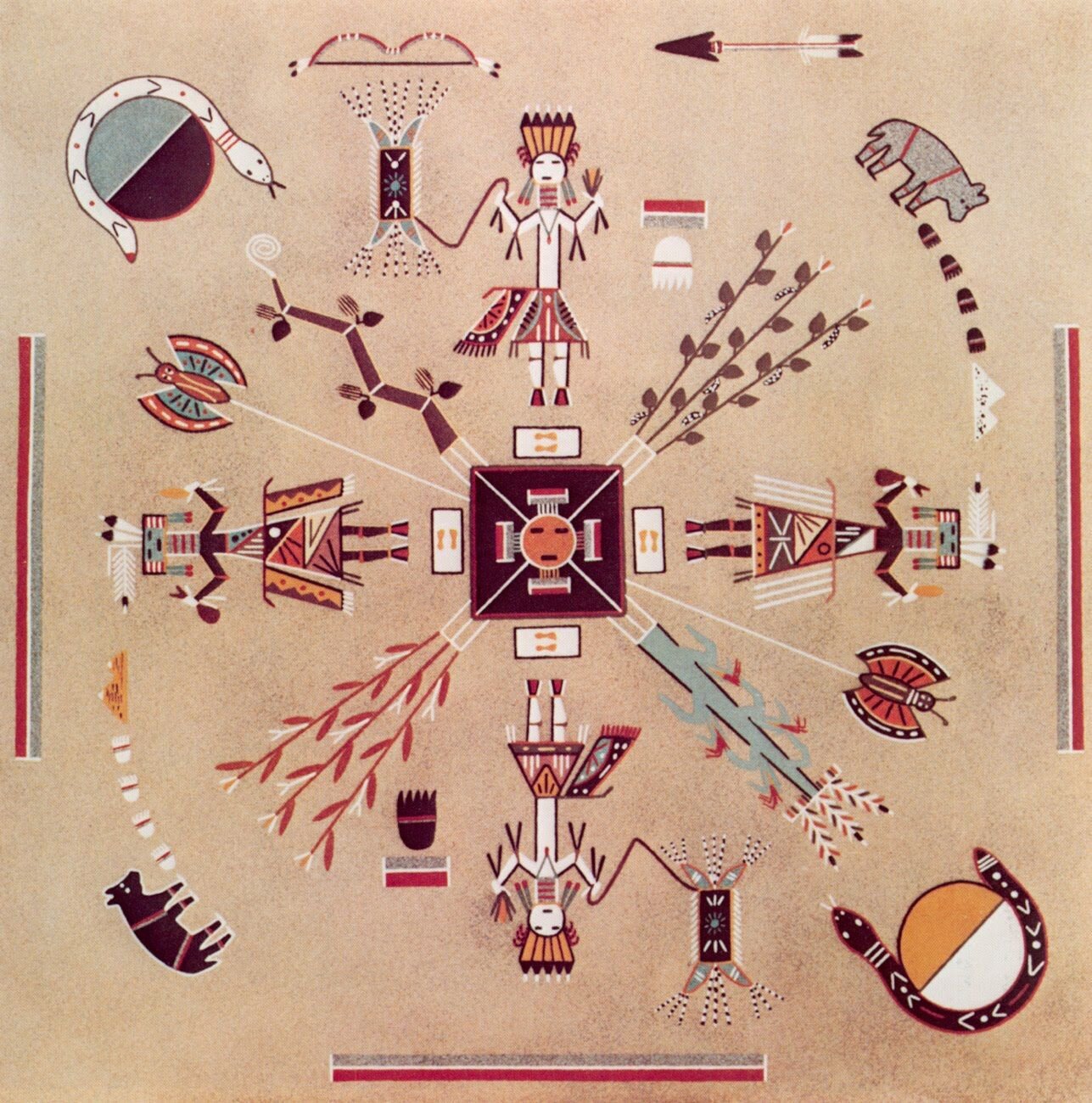
The Enduring Tapestry of Hózhó: Exploring the Sacred Healing Art of the Navajo Nation
In the vast, sun-drenched landscapes of the American Southwest, where the mesas rise like ancient sentinels and the wind whispers tales of time immemorial, resides a people known as the Diné, or Navajo. For centuries, they have cultivated a profound and intricate system of belief, culture, and healing, centered around the concept of Hózhó – a term that defies simple translation but encapsulates beauty, balance, harmony, and order. At the heart of this worldview lies the sacred healing art of the Navajo Nation, a complex tapestry woven from intricate sandpaintings, resonant chants, ritual, and an unparalleled understanding of the interconnectedness of all life. This is not merely folk medicine; it is a holistic spiritual science, a journey to restore cosmic equilibrium within an individual and their community.
The Navajo healing tradition is a living, breathing testament to an unbroken lineage of wisdom passed down through generations. Unlike Western medicine, which often compartmentalizes the body, mind, and spirit, the Diné perspective views illness not as an isolated physical ailment but as a manifestation of disharmony – a disruption of Hózhó. This imbalance can stem from a variety of sources: contact with negative influences, violation of sacred taboos, or a misalignment with the natural order of the universe. The purpose of a healing ceremony, or "sing" (known as Hataal in Navajo), is to re-establish this vital balance, guiding the patient back into a state of harmony with themselves, their community, and the cosmos.
At the core of these transformative ceremonies are two primary artistic expressions: the ephemeral sandpainting and the potent, meticulously memorized chants. Both are not merely aesthetic creations but functional, spiritual tools, imbued with immense power and purpose.
The Ephemeral Beauty of Sandpaintings
Perhaps the most visually striking element of Navajo healing art is the sandpainting, or ‘iikááh. These vibrant, intricate designs are not meant for display or preservation; they are created with painstaking care for a specific healing ceremony and are destroyed before sundown on the day they are made. This impermanence underscores a fundamental principle of Navajo philosophy: everything in the physical world is transient, and true healing lies in the spiritual realm.

The creation of a sandpainting is a sacred act, performed by the Hataałii (Singer or medicine person) and his assistants, often in the hogan, the traditional Navajo dwelling. Using finely ground natural materials – colored sand from sandstone, crushed minerals, charcoal, corn pollen, and even flower petals – the artists meticulously "paint" on a smooth bed of sand. The designs are not arbitrary; they are precise, sacred depictions derived from ancient myths and origin stories, illustrating figures of the Holy People (Diyin Diné’e), natural phenomena, and cosmic forces. Each line, color, and symbol carries profound meaning, often representing sacred journeys, protective deities, or the pathways to restoration.
For instance, common motifs include the Ye’ii Bicheii (Grandfather of the Gods), the Gila Monster (symbolizing healing and protection), cornstalks (representing life and sustenance), and various animal figures. The colors themselves are symbolic: white for dawn, blue for day, yellow for dusk, and black for night, mirroring the cyclical nature of life and the universe. The patient sits or lies directly on the finished sandpainting, physically entering the sacred space depicted. It is believed that the Holy People, invoked through the accompanying chants, will then enter the patient’s body through the sandpainting, absorbing the illness or disharmony and restoring the individual’s Hózhó. As one elder eloquently stated, "The sandpainting is not merely a picture; it is a portal, a sacred map for the spirit’s return to harmony. It draws the patient into the very essence of creation."
The destruction of the sandpainting at the ceremony’s conclusion is as vital as its creation. The sickness, absorbed by the painting, is ritually disposed of, ensuring it does not linger or harm others. This act reinforces the idea of renewal and release, allowing the patient to emerge cleansed and rebalanced.
The Resonant Power of Chants and Songs
While sandpaintings provide a visual anchor for the healing process, it is the extensive repertoire of chants and songs that form the very heart and soul of Navajo healing ceremonies. These are not simple melodies; they are epic poems, prayers, and invocations, often lasting for hours or even days, meticulously memorized and passed down through generations of Hataałii. A single ceremony can involve hundreds, sometimes thousands, of distinct songs, each with specific words, melodies, and rhythmic patterns, all integral to its particular purpose.
The chants serve multiple functions. They narrate the origin stories of the Diné, recounting how the Holy People emerged from previous worlds, created the current one, and established the sacred laws and ceremonies. By recounting these myths, the Hataałii connects the patient to this primordial wisdom, reminding them of their place within the grand cosmic narrative. The words themselves are believed to carry immense spiritual power, invoking the Holy People and inviting them to participate in the healing. "Our songs are living prayers," explains a Navajo singer. "They are the language of the Holy People, and through them, we call upon the universe to mend what is broken."
The delivery of these chants is a precise art form. The Hataałii must possess not only an extraordinary memory but also a deep understanding of the nuances of pitch, rhythm, and vocal inflection. The repetitive nature of many chants is not monotonous; rather, it creates a meditative, trance-like state for both the patient and participants, fostering an environment conducive to spiritual transformation. The songs guide the patient’s spirit, cleanse negative energies, and infuse positive forces, literally singing them back into health.
The Role of the Hataałii: Scholar, Artist, Healer
The orchestrator of these complex ceremonies is the Hataałii, or Singer. This role is not simply that of a medical practitioner but encompasses aspects of priest, historian, psychologist, and artist. Becoming a Hataałii is a lifelong commitment, requiring decades of rigorous apprenticeship under an elder Singer. This training involves memorizing entire ceremonial cycles – the specific order of events, the hundreds of songs and prayers, the intricate sandpainting designs, and the precise rituals. It is an immense intellectual and spiritual undertaking, demanding unwavering dedication and a profound connection to the Diné spiritual tradition.

The Hataałii must also possess a deep understanding of human nature and the specific needs of the patient. Through diagnosis, which can involve divination and careful observation, the Singer determines which specific ceremony (e.g., Blessingway, Nightway, Enemyway) is appropriate for the patient’s particular imbalance. Each ceremony is designed to address different forms of disharmony and invoke specific Holy People. The Hataałii acts as a bridge between the physical and spiritual worlds, guiding the patient on a journey of internal realignment.
Holistic Healing and Community Engagement
Navajo healing is inherently holistic, addressing not just the physical symptoms but the emotional, mental, and spiritual well-being of the individual. Illness is a signal that something is amiss in the patient’s life or their relationship with the world. The healing process encourages introspection, self-correction, and a renewed commitment to living in harmony.
Furthermore, these ceremonies are not solitary affairs; they are community events. Family members, friends, and neighbors gather to support the patient, offering their presence, prayers, and assistance. This communal participation reinforces the idea that an individual’s well-being is intertwined with the well-being of the entire community. The collective energy and intention of the group contribute significantly to the healing process, creating a powerful environment of shared purpose and support. This aspect highlights a key difference from many Western medical practices, where the patient often experiences illness in isolation.
Preserving an Ancient Wisdom in a Modern World
In the 21st century, the sacred healing art of the Navajo Nation faces both internal and external challenges. The allure of Western medicine, the decline of the Navajo language among younger generations, and the immense time and dedication required to become a Hataałii all contribute to a dwindling number of fully trained Singers. The intricate knowledge, traditionally passed down orally, is vulnerable to loss.
However, there are robust efforts within the Navajo Nation to preserve and revitalize these invaluable traditions. Elders and cultural leaders are working tirelessly to mentor younger generations, documenting ceremonies (with appropriate respect for sacred boundaries), and fostering a renewed appreciation for Diné cultural identity. Programs focus on language immersion and cultural education, recognizing that the health of the language is inextricably linked to the health of the ceremonies. As one Navajo leader asserted, "Our ceremonies are not just ancient practices; they are living prayers for the future of our people. To lose them would be to lose a part of our soul."
The sacred healing art of the Navajo Nation stands as a profound testament to human ingenuity, spiritual depth, and an enduring connection to the natural world. It is a system that reminds us that true healing transcends the purely physical, embracing the beauty, balance, and harmony that define Hózhó. In an increasingly fragmented world, the Diné’s ancient wisdom offers a powerful vision of holistic well-being, a journey back to the sacred center of existence, where art, song, and spirit converge to mend the human soul. It is a heritage deserving of profound respect, understanding, and continued reverence for its unparalleled contribution to the tapestry of human healing.